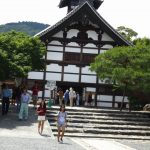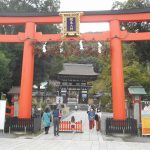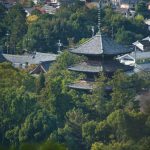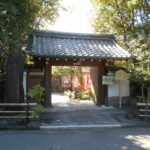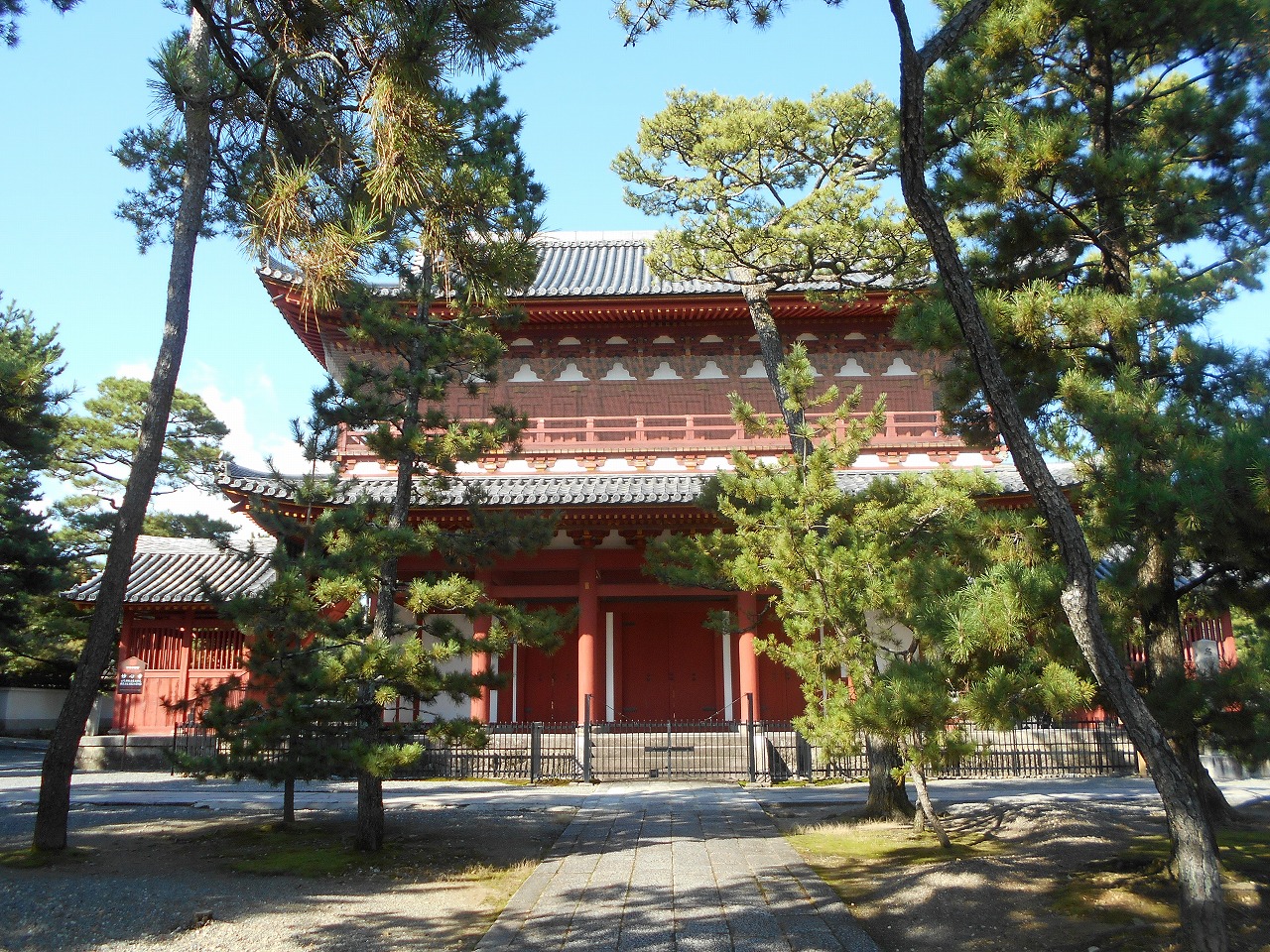
ページの目次
Myoshin-ji Temple(妙心寺)
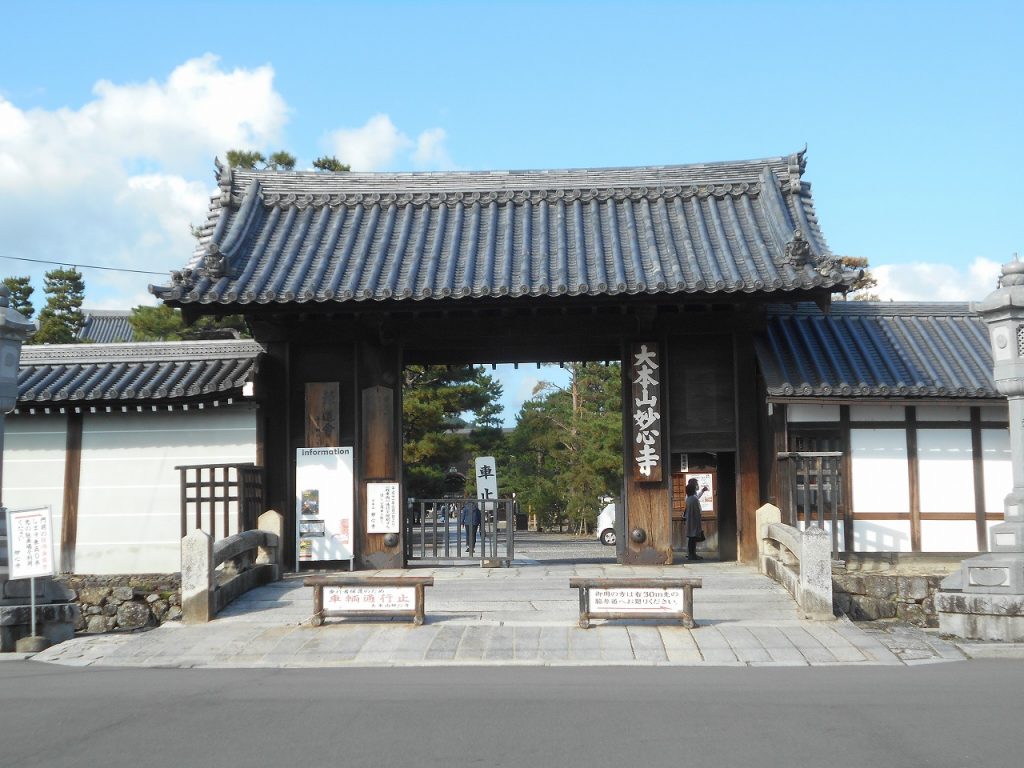
1. Location-Access
This temple is located near JR Hanazono station, at Rakusai Area in Kyoto.
It takes 12 minutes by JR Sagano Line from Kyoto sta. to Hanazono, five-minute walk.
Or it takes 45 minutes by city bus #26 from Kyoto sta. to Myoshinji-katamon-mae.
(この寺は、洛西エリアでJR花園駅の近くに位置している。JR嵯峨野線で京都駅から花園駅(12分)、徒歩5分。又は、市バス#26系統 京都駅(約40分)→妙心寺北門前、(徒歩5分)→妙心寺 )
2. Who was this temple built ?
1) In 1337, it is said that this temple was Hanazono Houou assigned Egen Kanzan as the founding patron and changed the name of detached place Hagiwara-den to Myoshin-ji.
The principality is Syaka Nyorai.
(1337年、深く禅宗に帰依された花園法皇が開山慧玄を開山とし、離宮萩原殿を妙心寺と変更した。本尊は釈迦如来である。)
2) Nyoshin-ji was against the rating of Rinzai Sect by Yoshimitsu because he had a harsh zen style to value training with Daitoku-ji. And it was confiscated for due to the Ounin war after renaissance and changed the name to Ryoun-ji.
But it reconstructed by Soushin Settuko in 1477.
(義満の臨済宗格付に対して、修行を重んじる厳しい禅風であった大徳寺と共に反対した。
そのため、1392年応仁の乱に乗じて領地を没収され、龍雲寺と改名した。
1477年、その後、雪江宗深によって再建された。)
3) The temple has many famous priest-graduates and extended power even countryside.
Currently it has 3500 sub-temples and it is the biggest Sect among Rinzai Sect.
(弟子にも名僧が出て、数多くの塔頭が建てられ地方への勢力は発展した。現在末寺3500
余りで臨済宗派の中最大である。 )
3. What is this temple famous for ?
1) Buddhism large temple complex 禅式の大伽藍
① You may see the three Gates, Buddhist Hall, Lecture Hall, Bed room and Daihoujyo
in the northern area of Chokushi-mon, Bath room, Bell Tower and Literary in the eastern area. The architecture from late Muromachi to early Edo was the most complete form of the Zen Buddhist temple. Two gardens of Houjyo are neat, clean and very popular.
(勅使門より北へ三門、仏殿、法堂、寝堂、大方丈が一直線に並び、その東側に浴室、
浴室、鐘楼、経蔵が並ぶ。室町後期から江戸初期の建築で、近世禅宗伽藍の最も完備
した形をしていた。大方丈の二面庭園はきちんとして清潔で人気のある名園である。)
② The bell placed in the temple is called “bell of Oushikicho”. It is called in 698and it is the oldest Zaimei Zell in Japan. It is superior in terms of the shape and tone color. The temple has more than 40 sub-temples and amazed as HQ of Zen Sect.
(法堂内に収蔵されている鐘は黄鐘調の鐘と言われ、698年我が国最古の在銘鐘であり、
形、音色に優れている。また、塔頭は40余りに達し、禅宗本山として、堂々たる寺容を誇る。)
2) Sub-temple in the this temple 山内塔頭
Myoushi-ji has 36 sub-temples in this temple. Especially, these temples show a beautiful
roof and connected roof looks like singing lightly. The roofs with tiles are art.
(妙心寺には、36の山内塔頭があり、特に、独特の屋根の美しさを見せてくれる。連なる
屋根は、三連符のように屋根が軽やかに歌っている。瓦屋根は芸術である。)
4. What is highlight ?
伽 藍
1) 南総門(重要文化財) Minami-soumon

Minami-soumon was built in 1610 of Edo period and convenient in using Hanazono station.
(江戸時代1610年建立で、JR花園駅を利用する場合便利である。)
2) 勅使門(重要文化財) Chokusi-mon
Chokushi-mon was built in 1610 of Edo period and is a gate without opening..
(江戸時代1610年建立で、南総門の近くにある開かずの門である。)
3) 北門(重要文化財) Kita-mon
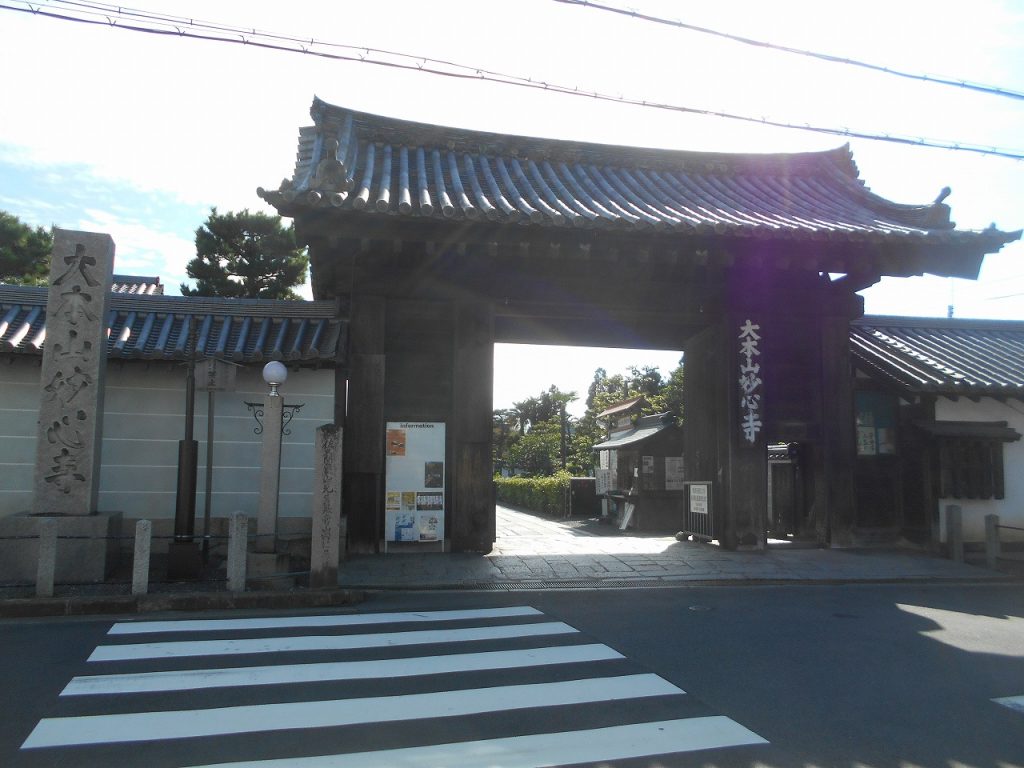
Kita-mon is built in 1610 of Edo period and located in the north of Myoushi-ji.
(江戸時代1610年建立で、妙心寺の北側に位置する。)
4) 前庭(重要文化財) Meniwa
In entering Minami-mon, you can see Maeniwa located at Houjyo-pond of the left side.
(南門から入ると、左手に方丈池に配された前庭がある。)
5) 三門(重要文化財) Sanmon
Inside of Myoushin-ji, it is so wide and quite in here. A gate with brilliant red pillars and other buildings are placed orderly in a line such as San-mon, Butsudan and Hatto.
On beams and columns, the Dragon, Phoenix and Calestial maiden are drawn powerfully.
(妙心寺境内は広く静かであり、赤い柱が鮮やかなで一列に延びる三門、仏堂、法堂などの建物が整然としている。梁や柱には、龍や鳳凰、飛天が力強く描かれている。上層部には、観音菩薩像、十六羅漢像が祀られている。)
6) 仏殿(重要文化財) Butsuden
In passing through Sanmon, we can see Butsudan which is enshrined Syaka Nyorai statue of the Principality.
(三門を潜ると仏殿で、安土桃山1583年建立で、ご本尊の釈迦如来像が祀られている。)
7) 法堂(重要文化財) Hatto
Hatto is built in 1656 of Edo period. The dragon painting on the ceiling is on “Unryu” or Cloud dragon figure” made by Tanyuu Kano. It’s very famous.
It’s called “Happo-nirami –no-ryu” or “dragon that glares in all directions.
Because it looks like that the dragon glaring at you, no matter where you stand .
The big bell placed inside of the Hatto hall made about 1300 years ago. It is said to be the oldest bell in Japan with the year of casting written on it.
(江戸時代1656年建立で、天井の狩野探幽作の迫力満点の雲龍図を見ることができる。
「八方にらみの龍」と呼ばれている。どこから見ても龍に睨まれているように見えることから。また、法堂内の梵鐘は1300年ほど前に造られたものである。
年代が記されたものとしては、日本で最も古い。)
8) 寝堂(重要文化財) Shin-do
Shin-do was built in 1656 of Edo period and is a building connected by Hatto and crossing corridor.
(法堂と渡り廊下で繋がっている建物で江戸時代1656年建立。)
9) 大方丈(重要文化財) Daihoujyo
This shrine was built in 1654 and the Kano school was decollated with barrier paintings inside.
(江戸時代1654年建立で、内部には、狩野派の障壁画が飾られていた。
5.塔頭寺院
1) 退蔵院(公開) Taizou-in
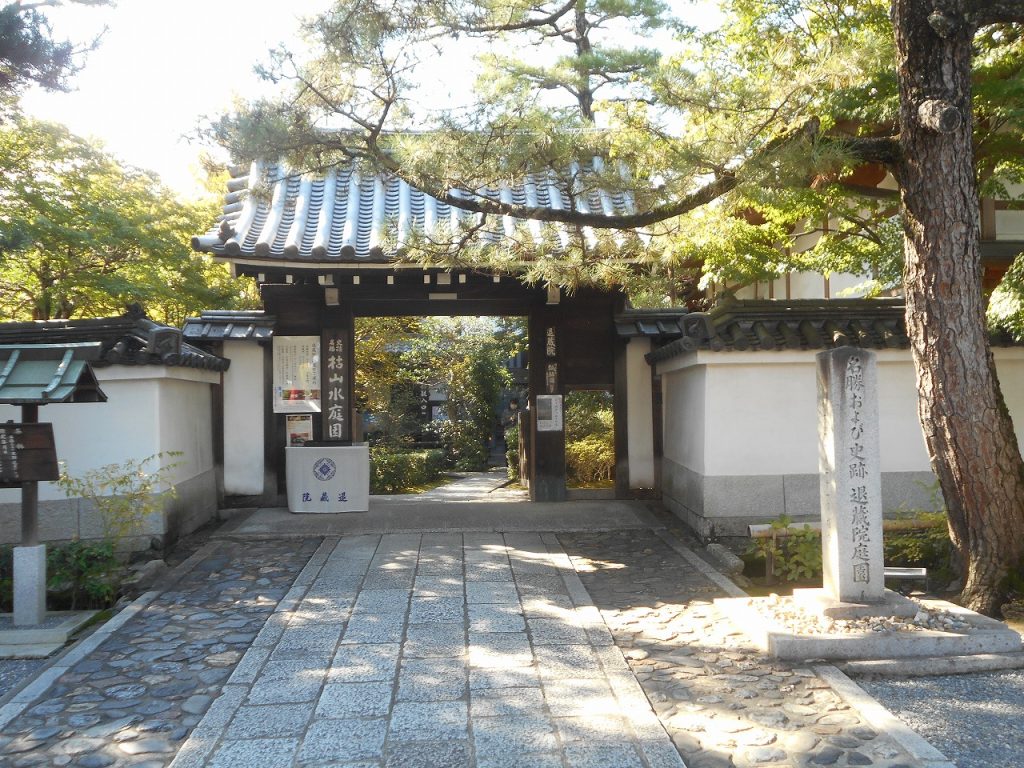
Taizou-in is famous for “Hyounenzu(National Treasure)” made by Josetsu, Japan’s early representative ink painting.
(日本の初期水墨画の代表作である如拙筆の国宝「瓢鮎図」を所有。妙心寺塔頭の中でもかなり大きい敷地を有する。
画像:退 蔵 院
2) 大心院(公開) Daishin-in
Dry style garden, “Aun no niwa” is a cozy garden, centered on Sanso-stone located in white sand, moss and stone.
(枯山水庭園「阿吽の庭」は、三尊石を中心に白砂と苔と岩を配した安らぐ庭。)
3) 柱春院(公開) Keishun-in
The garden, “Shinnyo no miwa”, featuring thick hair moss and rhododendrons has been designated a historic site and a scenic spot.
(杉苔とツツジの植え込みが見どころの庭園は、史跡・名勝に指定。「真如の庭」)
4) 大通院(非公開) Daitsuu-in
Kazutoyo Yamanouchi’s corridor and portrait .
(山内一豊夫妻の御陵と肖像画。)
5) 龍泉庵(非公開) Ryosen-an
Tohaku Hasegawa, “Monkeys and a Bamboo Grove (Important Cultural Property).
(国の重要文化財長谷川等伯筆「古木猿候図」を所蔵。)
